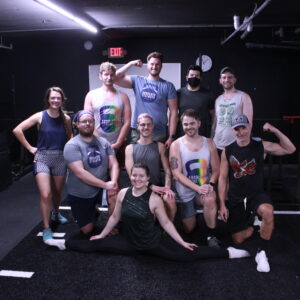 By Emilie Bouvier
By Emilie Bouvier
“Eight… Nine… Ten.”
I finish the count with a strain and glance up, squinting at fluorescent lights. Another set down. I put down the dumbbells and move over to the kettlebell for deadlifts, next in the circuit.
Two years ago, I would have never imagined that I’d relish this – the sweat and exertion of a grueling strength-building workout.
But the thing is, as I get into alignment on the mat with a heavy weight in front of me, everything else fades away. All I have capacity to concentrate on is that 96Lb of cast iron and my effort to pick it up.
“One… Two… Three…”
We’ve been talking a lot these days about resiliency. And as unexpected as it’s been, this challenging workout class came to be a saving grace for me during a season that would have otherwise broken me, I’m sure. It’s become a balm amid a particularly hard day or hard week.
“Two years ago, I would have never imagined that I’d relish this.”
I know I’m a little bit biased because it’s my brother who runs the class, but the added sibling time is just a bonus. Now, not only do I have a whole new appreciation for what my brother’s work is like as a personal trainer, but I also have a whole new understanding of what it looks like to tend to my body in building resiliency.
I’ve become much more attuned to how much we hold onto our experiences physically, and just how physical our need is for health, connection, and healing.
PART OF THIS JOURNEY TOWARD EXERCISE AS A RESILIENCY PRACTICE was fueled by a dear friend recommending the book “Breaking the Burnout Cycle,” by Emily and Amelia Sagoski. She didn’t offer this as an optional suggestion; she literally left it at my house and demanded I read it! Of course, in true irony I only found time to get through the first chapter. Yet, even that short excerpt was a helpful guide for using exercise as way to visualize and physically let go of the tension I’m so used to holding onto.
As I’ve been reading another book that’s sat on my shelf all too long, “My Grandmother’s Hands” by Resmaa Manakem, I’ve also come to see my physical workouts as a way to better connect with and settle my body. Alongside the other embodied practices in the book, I’ve found strength-building has helped me metabolize my emotions and work to reroute the perpetuated harms of racialized trauma responses held in my body.
 I know exercise isn’t everyone’s best strategy for resiliency; it’s a good and helpful pathway, but the pathways are many.
I know exercise isn’t everyone’s best strategy for resiliency; it’s a good and helpful pathway, but the pathways are many.
For me, all I know is that at the end of the day if I can show up and slam a medicine ball on the ground that I’ll be ok. And most
days, that’s enough. At the end of the workout, when I’m lying on the astroturf in a sweaty gym basement, I put my shaky, noodle-feeling arms on my stomach and feel myself breathing. In that moment of rest, I feel deeply and physically connected to my own humanity, my vulnerability, my strength. By that point I’ve physically worked out all the frustration, mental lists, and hurts of the day, and in my exhaustion, I feel on a gut-level that I’m ok. And that I’m claimed and loved by God.
This is a similar muscle memory, I think, to that of ministry. A lot of church work is taking on the repeat rhythms, putting forward your best effort, and pushing when you’re spent and it’s all you can do to go through motions one more time. But then doing the thing, letting go, and remembering that you are loved.
“At the end of the day if I can show up and slam a medicine ball on the ground, I’ll be ok.”
Whatever your resiliency practice is right now, I hope it connects you back to your sacred humanity and moments of rest in God’s grace. After all, this challenging yet beautiful season of Lent is marked by God’s walking with us through the physicality, stress, and messiness of being human.
[Again, I’m biased, but if you’re looking for a personal trainer, I can’t recommend my brother Alex highly enough! absolutestrengthmn.com]

